Gigantic Unfinished Stone Structures Cut With Amazing Stone-Working Techniques
A. Sutherland - AncientPages.com - The Yangshan Quarry is famous for an unfinished stele of huge size that was abandoned there during the reign of the Yongle Emperor, the third ruler of the Ming Dynasty in China, reigning from 1402 to 1424.
The Yangshan Quarry, an ancient stone quarry near Nanjing, China, was used during many centuries as a source of stone for buildings and monuments of Nanjing. It is now preserved as a historic site.
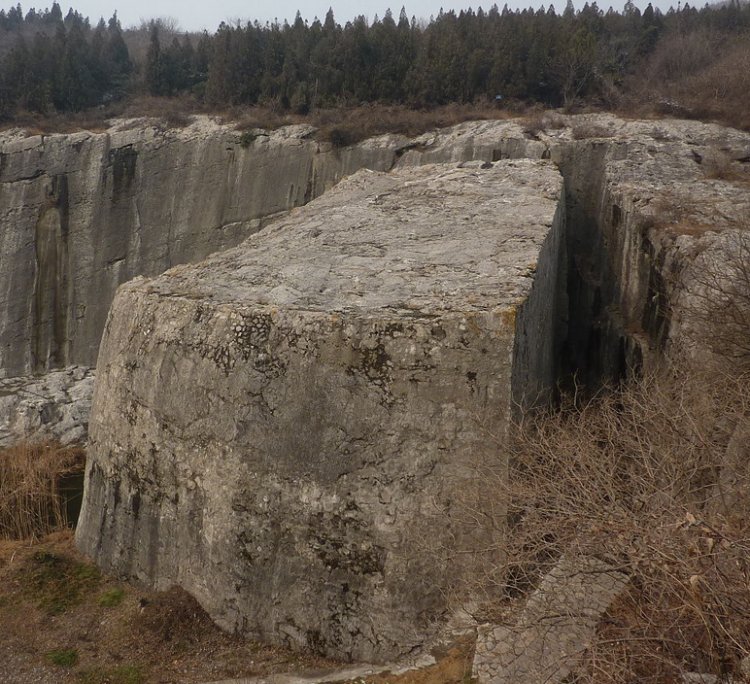
Yangshan unfinished stele, China -The stele base, partly separated from the body of the mountain. Photo: Wikipedia
In 1405, the Yongle Emperor, ordered the cutting of a giant stele in this quarry, for use in the Ming Xiaoling Mausoleum of his deceased father.
Three separate pieces were being cut: the rectangular stele base (pedestal), the stele body, and the stele head (crown, to be decorated with a dragon design). After most of the stone-cutting work had been done, the architects realized that moving stones from the quarry to Ming Xiaoling and installing them there in a proper way, would not be physically possible.
As a result, the project was abandoned and the three unfinished stele components remain in Yangshan Quarry to this day.
The present dimensions and the usual weight estimates of the steles are as follows:
The Stele Base is 30.35 m long, 13 m thick, 16 m tall, and weighs 16,250 metric tons. Its body is 49.4 m long, 10.7 m wide, 4.4 m thick and weighs 8,799 tons. The stele's head is 10.7 m tall, 20.3 m wide, 8.4 m thick and weighs 6,118 tons.
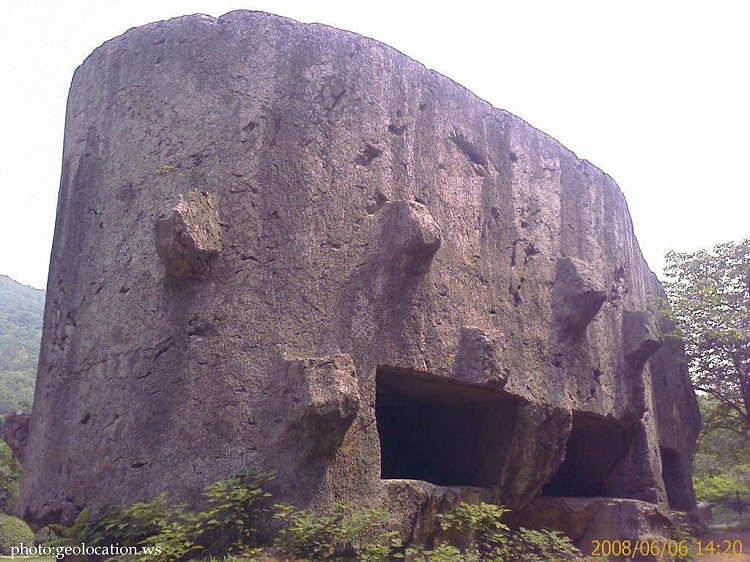
The unfinished "Monument Head" (image above) and the side of the Monument Body sitting still attached to the living rock in the middle of the north-eastern pit of the Yangshan Quarry, now nicely landscaped. The "head" is the top part of the stele, which, in a finished stele would probably have been fashioned into a dragon design.
According to experts, if the stele had been finished and put together, by installing the stele body vertically on the base, and topping with the stele head, then it would have stood 73 meters tall.
Legend has it that workers who failed to produce the daily quota of crushed rock of at least 33 sheng would be executed on the spot.
In memory of the workers who died on the construction site-including those who died from overwork and disease-a nearby village became known as Fentou, or "Grave Mound".
Today, the place is also called "Death's Head Valley".
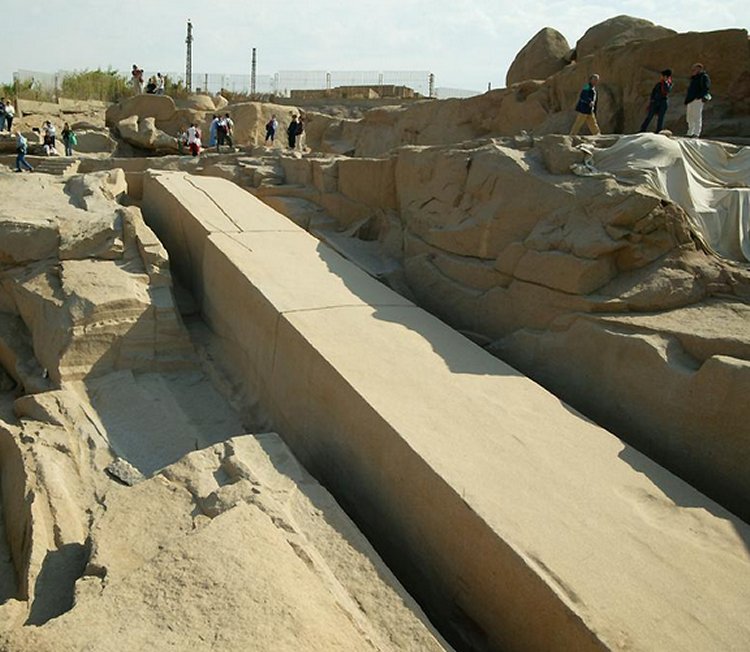
The obelisk's creators began to carve it directly out of bedrock, but cracks appeared in the granite and the project was abandoned. Originally it was thought that the stone had an undetected flaw but it is also possible that the quarrying process allowed the cracking to develop by releasing the stress. The bottom side of the obelisk is still attached to the bedrock. (via clubvision-eg)
Another unfinished gigantic stone structure is located in the northern region of the stone quarries of ancient Egypt in Aswan (Assuan), Egypt. It was ordered by Hatshepsut (1508–1458 BC), possibly to complement the Lateran Obelisk (originally at Karnak, and later brought to the Lateran Palace in Rome).
It is nearly one third larger than any ancient Egyptian obelisk ever erected. If finished it would have measured around 42 m (approximately 137 feet) and would have weighed nearly 1,200 tons.
The unfinished obelisk offers unusual insights into ancient Egyptian stone-working techniques, with marks from workers' tools still clearly visible as well as ocher-colored lines marking where they were working.
At the southern entrance of Baalbeck is a quarry where the stones used in the temples were cut. A huge block, considered the largest hewn stone in the world (another ancient stone block is also nearby) still sits where it was cut almost 2,000 years ago.
Called the "Stone of the Pregnant Woman", it is 21.5m x 4.8m x 4.2meters in size and weighs an estimated 1,000 tons. Similar stone blocks of a 20m-length were used for the podium of the huge Temple of Jupiter in the Roman sanctuary of Baalbeck.
Written by – A. Sutherland - AncientPages.com Senior Staff Writer
Copyright © AncientPages.com All rights reserved. This material may not be published, broadcast, rewritten or redistributed in whole or part without the express written permission of AncientPages.com
Expand for referencesReferences:
More From Ancient Pages
-
 Human Occupation In Lava Tube Cave In Saudi Arabia – First Evidence Discovered
Archaeology | Apr 18, 2024
Human Occupation In Lava Tube Cave In Saudi Arabia – First Evidence Discovered
Archaeology | Apr 18, 2024 -
 ‘Viking Disease’ Hand Disorder May Come From Neanderthal Genes
Archaeology | Jun 14, 2023
‘Viking Disease’ Hand Disorder May Come From Neanderthal Genes
Archaeology | Jun 14, 2023 -
 Headless remains related to Huns or Sarmatians puzzle archaeologists in Kazakhstan
News | Aug 30, 2015
Headless remains related to Huns or Sarmatians puzzle archaeologists in Kazakhstan
News | Aug 30, 2015 -
 Something Strange Happened To Our Ancestors 900,000 Years Ago – Genetic Study Reveals
DNA | Sep 1, 2023
Something Strange Happened To Our Ancestors 900,000 Years Ago – Genetic Study Reveals
DNA | Sep 1, 2023 -
 Mystery Of The Yaghan People: The First True Discoverers Of America?
Civilizations | Sep 19, 2016
Mystery Of The Yaghan People: The First True Discoverers Of America?
Civilizations | Sep 19, 2016 -
 Dice Existed Long Before Recorded History And Were Not Always Perfect Cubes
Archaeology | Feb 1, 2018
Dice Existed Long Before Recorded History And Were Not Always Perfect Cubes
Archaeology | Feb 1, 2018 -
 Din Lligwy: Prehistoric Celtic Settlement Of Anglesey, Wales
Featured Stories | Dec 3, 2022
Din Lligwy: Prehistoric Celtic Settlement Of Anglesey, Wales
Featured Stories | Dec 3, 2022 -
 Immigrants In Prehispanic Cancun Were Treated Just Like Maya Locals
Archaeology | Oct 26, 2023
Immigrants In Prehispanic Cancun Were Treated Just Like Maya Locals
Archaeology | Oct 26, 2023 -
 Spicy History Of Chili Peppers – Study From University Of Alabama
Archaeology | Nov 20, 2024
Spicy History Of Chili Peppers – Study From University Of Alabama
Archaeology | Nov 20, 2024 -
 Uruk Prophecy Found In The Ancient Library Of A Magician With Divine Powers
Artifacts | Jul 8, 2019
Uruk Prophecy Found In The Ancient Library Of A Magician With Divine Powers
Artifacts | Jul 8, 2019 -
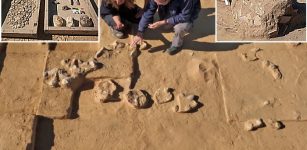 Ostrich Eggs Dated More Than 4,000 Years Discovered In Negev Desert Of Southern Israel
Archaeology | Jan 13, 2023
Ostrich Eggs Dated More Than 4,000 Years Discovered In Negev Desert Of Southern Israel
Archaeology | Jan 13, 2023 -
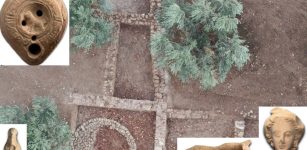 Ancient City Of Tenea Built By Trojan Prisoners Reveals More Archaeological Secrets
Archaeology | Feb 15, 2023
Ancient City Of Tenea Built By Trojan Prisoners Reveals More Archaeological Secrets
Archaeology | Feb 15, 2023 -
 Ancient Underground Tombs And Lightening God In Peru – Complex Concepts Of Death And Renewal Revealed
Archaeology | May 22, 2018
Ancient Underground Tombs And Lightening God In Peru – Complex Concepts Of Death And Renewal Revealed
Archaeology | May 22, 2018 -
 What Was Legio Martia And Why Were The Roman Soldiers Called The Martians?
Ancient History Facts | Jan 5, 2018
What Was Legio Martia And Why Were The Roman Soldiers Called The Martians?
Ancient History Facts | Jan 5, 2018 -
 Non-Invasive Radar Will Search King Tutankhamun’s Tomb For Nefertiti’s Hidden Crypt
Civilizations | Sep 24, 2015
Non-Invasive Radar Will Search King Tutankhamun’s Tomb For Nefertiti’s Hidden Crypt
Civilizations | Sep 24, 2015 -
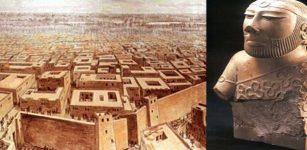 Controversial Ancient History Of Harappa And Mohenjo Daro – Advanced Indus Valley Civilization Pre-Dates Egypt’s Pharaohs And Mesopotamia
Civilizations | Apr 15, 2017
Controversial Ancient History Of Harappa And Mohenjo Daro – Advanced Indus Valley Civilization Pre-Dates Egypt’s Pharaohs And Mesopotamia
Civilizations | Apr 15, 2017 -
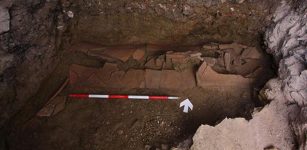 Roman-Byzantine Grave Unearthed In Turkey
Archaeology | Jan 28, 2016
Roman-Byzantine Grave Unearthed In Turkey
Archaeology | Jan 28, 2016 -
 Ancient Egyptians Had The First Governmental Health Care System
Ancient History Facts | Jul 6, 2018
Ancient Egyptians Had The First Governmental Health Care System
Ancient History Facts | Jul 6, 2018 -
 Mysterious Figurine Of Mythical Individual Dates Back To Egypt’s Naqada Culture 4400–3000 BC
Featured Stories | Sep 25, 2016
Mysterious Figurine Of Mythical Individual Dates Back To Egypt’s Naqada Culture 4400–3000 BC
Featured Stories | Sep 25, 2016 -
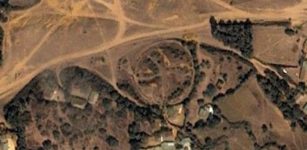 Was Megalithic Stone Circle Of Mzoura The Tomb Of Giant Antaeus?
Civilizations | Sep 5, 2015
Was Megalithic Stone Circle Of Mzoura The Tomb Of Giant Antaeus?
Civilizations | Sep 5, 2015

